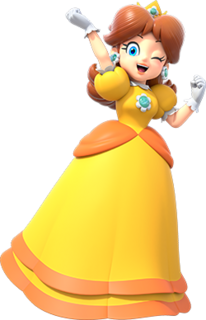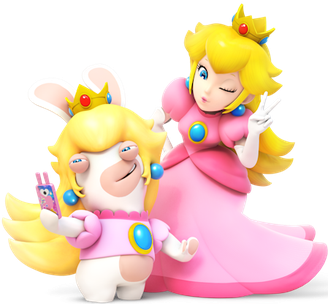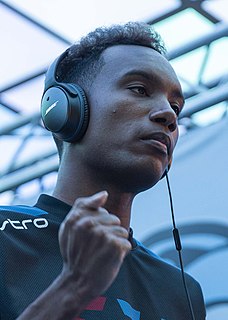
Luigi is a fictional character featured in video games and related media released by Nintendo. Created by Japanese video game designer Shigeru Miyamoto, Luigi is portrayed as the younger fraternal twin brother and sidekick of Mario, Nintendo's mascot. Luigi appears in many games throughout the Mario franchise, oftentimes accompanying his brother.

Mario is a fictional character created by Japanese video game designer Shigeru Miyamoto. He is the title character of the Mario video game franchise and the mascot of Japanese video game company Nintendo. Mario has appeared in over 200 video games since his creation. Depicted as a short, pudgy, Italian plumber who resides in the Mushroom Kingdom, his adventures generally center on rescuing Princess Peach from the Koopa villain Bowser. Mario has access to a variety of power-ups that give him different abilities. Mario's fraternal twin brother is Luigi.

Princess Peach Toadstool is a fictional character in Nintendo's Mario franchise, created by Shigeru Miyamoto and introduced in the 1985 original Super Mario Bros. installment. She is the princess regnant and ruler of the Mushroom Kingdom, where she resides in her castle along with Toads.

Super Mario Sunshine is a 2002 platform action-adventure game developed and published by Nintendo for the GameCube. It is the second 3D game in the Super Mario series, following Super Mario 64 (1996). The game was directed by Yoshiaki Koizumi and Kenta Usui, produced by series creators Shigeru Miyamoto and Takashi Tezuka, written by Makoto Wada, and scored by Koji Kondo and Shinobu Tanaka.

The Mushroom Kingdom is a fictional principality in Nintendo's Mario series. It is the setting of most main-series Mario games with an inconsistent presentation, and neighbors the Sarasaland Kingdoms. There is no established canon regarding the topography of the Mario universe, and many areas are not certain to be part of the Mushroom Kingdom.

The Mario franchise is a collection of video game series by Nintendo. While Nintendo is usually their developer and publisher, various series are usually developed by other third-party companies, such as Hudson Soft and Intelligent Systems. The games primarily revolve around Mario, and usually involve the motif of Bowser kidnapping Princess Peach and Mario rescuing her. Various characters have different plots and goals that vary in each series; for example, the Luigi's Mansion series focuses on Luigi ridding his new mansion of ghosts, while Wario stars in games that center around his greed and desire for money and treasure.

Bowser Jr. is a fictional character who appears in Nintendo's Mario franchise as an antagonist. He is the son of the series' main antagonist, Bowser. Since his debut in Super Mario Sunshine in 2002, Bowser Jr. has been a recurring character in the Mario series and has been made playable in several spin-offs, such as Mario Superstar Baseball, Mario Strikers Charged, Super Smash Bros. for Nintendo 3DS and Wii U, and Super Smash Bros. Ultimate among many others. He often helps his father to kidnap Princess Peach and defeat Mario, but in the end wants nothing more than to impress his father. Bowser Jr.’s defining traits are his striking resemblance to his father, his energetic and driven personality, his expertise in mechanics and technology, his heavy uses of his Junior Clown Car and Magic Paintbrush.

Super Princess Peach is a platform video game developed by Tose and published by Nintendo for the Nintendo DS handheld game console. It was released in Japan in October 2005 and worldwide the following year. Super Princess Peach is the second game to feature Princess Peach as the only main playable character after the game Princess Toadstool's Castle Run released in 1990 on the Nelsonic Game Watch.

Super Mario Bros.: The Great Mission to Rescue Princess Peach! is a 1986 Japanese anime film, based on the Super Mario Bros. video game. Directed by Masami Hata and produced by Masakatsu Suzuki and Tsunemasa Hatano, the plot centers on Mario and Luigi, who go on a quest to save Princess Peach from King Koopa, after she escapes from her video game. It is notable for being the first movie based on a video game, a distinction shared with Running Boy: Star Soldier's Secret, as it released on the same day, and predating the live-action Super Mario Bros. movie by seven years.
Momotarō Densetsu, also known by the abbreviated name Momoden, is a role-playing video game series in Japan featuring the character Momotarō from Japanese folklore, as well as other Japanese folklore characters such as Kintarō, Urashima Tarō, and Princess Kaguya. The first game in franchise, 'Momotarō Densetsu, had shipped 1 million copies in Japan.
Amii Ozaki, real name Misuzu Ohara, is a Japanese singer songwriter born on 19 March 1957 in Kita-ku, Kyoto, Kyoto Prefecture, Japan. She has written music such as Oribia o Kikinagara by Anri and Tenshi no Uinku by Seiko Matsuda, as well as many other songs. Ozaki makes irregular appearances on her friend Akira Kamiya's internet radio show Kamiya Akira Hot Beat Party. Her husband is musician Ray Ohara. Her mother is Akemi Ozaki, a maker of popular handbags and purses made from vintage obi.
Tanerau Dylan Latimer is a New Zealand rugby union footballer who plays for the Bay of Plenty.

Princess Daisy is a fictional character in the Mario series of video games. She debuted in 1989's Super Mario Land as the ruler of Sarasaland. Described as a tomboy, she has been rumored to be Luigi's love interest, similarly to Princess Peach being the love interest of Mario. This became the plot of the 1993 live-action film Super Mario Bros., in which Luigi saves Daisy from King Koopa.

Toad is a fictional character who primarily appears in Nintendo's Mario franchise. A humanoid with a mushroom-like head, Toad was created by Japanese video game designer Shigeru Miyamoto, and is portrayed as a citizen of the Mushroom Kingdom and is one of Princess Peach's most loyal attendants, constantly working on her behalf. They are usually seen as a non-player character who provides assistance to Mario and his friends in most games, but there are times when Toad takes center stage and appears as a protagonist, as seen in Super Mario Bros. 2, Wario's Woods and Super Mario 3D World.

Rosalina, known as Rosetta in Japan (ロゼッタ), is a fictional character in the Mario series of video games. She debuts in Super Mario Galaxy, where she acts as a non-player character who resides in the Comet Observatory, the game's hub world. She is the adoptive mother of the Lumas, a fictional species of stars in the game, and also watcher of the cosmos. Rosalina has since appeared as a player character in subsequent Mario games, such as the Mario Kart, Mario Golf, Mario Party, and the Super Smash Bros. series.
Takahiro Ogawa is a Japanese international rugby union player who plays as a scrum-half. He currently plays for the Sunwolves in Super Rugby and Toshiba Brave Lupus in Japan's domestic Top League.

Bowsette or Koopa-hime, is a fan-made, moe anthropomorphized and gender-swapped version of the Mario franchise character Bowser, in which he is transformed to resemble the character Princess Peach using a power-up. The character was created on 19 September 2018, by a Malaysian artist named Ayyk92 as part of a comic strip which he posted online. Bowsette quickly rose in popularity internationally, with related hashtags in English and Japanese trending on Twitter. Bowsette is typically portrayed as a blonde woman with horns, fangs, a spiked collar with matching armbands and a black strapless dress. Several professional Japanese artists contributed their own renditions of the character. A convention themed around Bowsette was planned for October of the same year.

Rabbid Peach is a fictional character from the Rabbids video game franchise. First appearing in the crossover video game Mario + Rabbids Kingdom Battle, Rabbid Peach is depicted as a rabbit-like creature who parodies the Mario franchise character Princess Peach by dressing like her namesake. The character initially became known through game leaks of Mario + Rabbids Kingdom Battle in early 2017, and quickly attained a popular following. Following the commercial and critical success of Mario + Rabbids Kingdom Battle, Rabbid Peach has appeared in other crossover media.

Ezra Samsora Morris, better known as Samsora, is an American former professional Super Smash Bros. player from New Orleans, United States.














